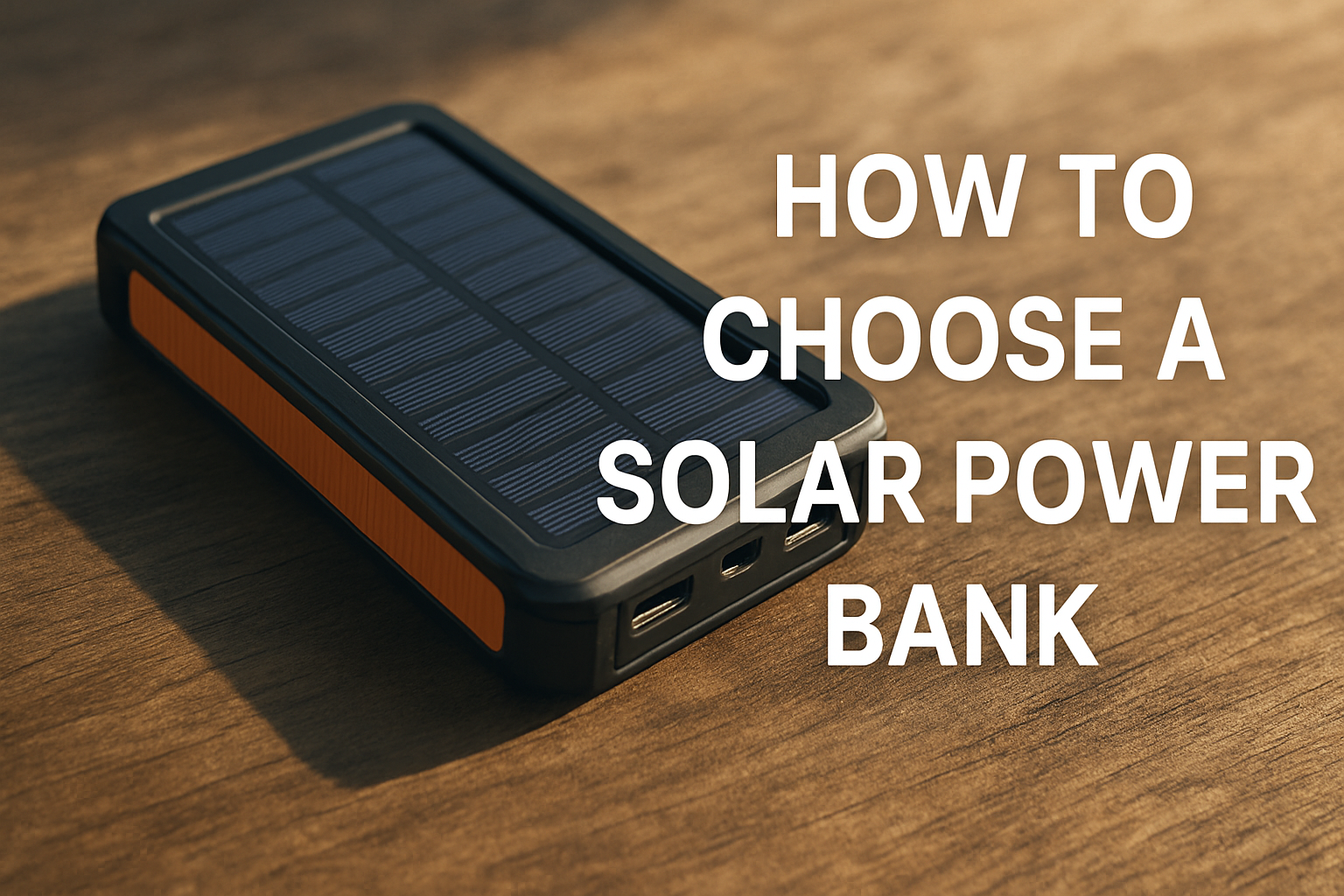As the world increasingly turns to renewable energy and off-grid solutions, solar power banks have emerged as a practical and eco-friendly choice for travelers, outdoor enthusiasts, and emergency preppers alike. But with dozens of models on the market—each boasting different capacities, charging speeds, and features—how do you actually choose the right solar power bank?
In this comprehensive guide, we’ll walk you through everything you need to know before buying a solar power bank in 2025. From understanding battery specs to identifying the best use cases, you’ll get actionable advice to confidently choose a model that matches your needs.
Table of Contents
- What Is a Solar Power Bank?
- Why Do You Need One?
- Key Factors to Consider Before Buying
- Battery Capacity
- Solar Panel Efficiency
- Charging Speed (Input/Output)
- Number and Type of Ports
- Build Quality and Durability
- Size and Portability
- Smart Charging Features
- Brand and Warranty
- Choosing Based on Use Case
- Common Mistakes to Avoid
- Top Features to Prioritize
- Recommended Brands and Models
- FAQs
- Final Thoughts
1. What Is a Solar Power Bank?
A solar power bank is a portable energy storage device equipped with solar panels, allowing it to recharge its internal battery using sunlight. Once charged, the battery can power mobile devices like smartphones, tablets, Bluetooth speakers, GPS units, and more.
Most models can be recharged via USB wall charging as well, making solar charging a backup or supplement. This dual-mode functionality is what sets them apart from conventional power banks.
2. Why Do You Need One?
A solar power bank is especially useful if you:
- Spend extended time outdoors (camping, hiking, fishing)
- Live in areas prone to power outages
- Travel frequently and may not always have outlet access
- Want to adopt a more eco-conscious lifestyle
- Need a sustainable power source during emergencies
In short, they’re ideal for anyone who values energy independence, sustainability, and off-grid reliability.
3. Key Factors to Consider Before Buying
Choosing a solar power bank isn’t just about grabbing the one with the biggest battery. You need to assess your needs and evaluate a variety of features. Here’s how to do that.
A. Battery Capacity (mAh or Wh)
Battery capacity determines how much energy the power bank can store and deliver.
- 10,000mAh: Charges a typical smartphone 2–3 times.
- 20,000–30,000mAh: Great for extended use, can charge a phone 5–6 times or a tablet twice.
- 40,000mAh and above: Ideal for multi-device users or shared use (groups/families).
Pro Tip: Calculate your average daily device usage and choose a bank that can meet at least 1.5x your daily need.
B. Solar Panel Efficiency
Not all solar panels are created equal. Efficiency refers to how well the panel converts sunlight into usable energy.
- Monocrystalline panels: Highest efficiency (19%–23%) and longer lifespan.
- Polycrystalline panels: Slightly lower efficiency (15%–18%) but often cheaper.
Also, consider the size and number of solar panels:
- Single-panel banks: Slower charging, but more compact.
- Foldable multi-panel banks: Faster solar charging and more practical for extended trips.
C. Charging Speed (Input & Output)
You want both quick charging of your devices and quick recharging of the power bank itself.
Input Speed:
- USB-C PD (Power Delivery): Fastest for wall charging.
- Solar input: Usually slower; even top-tier models may take 30–50 hours of direct sunlight for a full charge.
Output Speed:
- Look for models that support Quick Charge 3.0 or PD 18W/30W for fast-charging phones and tablets.
D. Number and Type of Ports
A good solar power bank should offer multiple ports for convenience:
- USB-A: Standard port, works with most devices.
- USB-C: Best for newer phones and tablets.
- Micro USB: Common for input charging (less favored in 2025).
- Wireless Charging Pad: Great if you want to ditch the cords.
For versatility, look for a bank with at least two output ports.
E. Build Quality and Durability
If you’re using your power bank outdoors, rugged design is non-negotiable. Features to look for:
- Waterproofing (IP65 or higher)
- Dust and shock resistance
- Reinforced corners and rubberized casing
- Sealed ports and buttons
Check for temperature tolerance if you live in areas with extreme heat or cold.
F. Size and Portability
There’s always a trade-off between power and portability.
- Slim, compact banks: Easy to carry, good for daily use, but lower capacity.
- Larger, fold-out panel models: Better solar input and higher capacity, but bulkier.
Choose a size that fits your intended use: pocket-sized for commuting, backpack-sized for trekking, or even suitcase models for base camps.
G. Smart Charging Features
Top-tier solar banks often include advanced power management systems, such as:
- Smart IC or AI Charging: Detects device type and adjusts output accordingly.
- Pass-Through Charging: Allows charging devices while the bank itself is charging.
- Overcharge/Overheat Protection: Ensures safety and battery health.
H. Brand Reputation and Warranty
Not all solar banks are created equal. Stick to well-reviewed brands that offer:
- Transparent specifications
- Responsive customer support
- At least a 12-month warranty
Reliable brands often use better-quality batteries and more efficient panels, justifying the slightly higher price tag.
4. Choosing Based on Use Case
Different users have different needs. Here’s how to pick based on your lifestyle:
Outdoor Enthusiasts
- 20,000mAh+
- Foldable multi-panel design
- Waterproof, dustproof
- Built-in flashlight and compass
Frequent Travelers
- Compact size
- Dual charging modes (USB + solar)
- 10,000–20,000mAh
- Lightweight and airport-safe
Emergency Use
- High-capacity (30,000mAh+)
- Strong solar capability
- SOS beacon or flashlight
- Can power small fans or lights
Daily Commuters
- Compact, stylish
- Wireless charging
- Fast wall charging (PD)
- Solar as backup only
5. Common Mistakes to Avoid
Many first-time buyers fall for marketing gimmicks. Here are mistakes to avoid:
- Over-relying on solar input: Most solar banks are not designed to be charged solely by the sun.
- Ignoring panel specs: Big doesn’t always mean efficient. Check actual wattage.
- Buying the cheapest option: Cheap components = poor performance and short lifespan.
- Not checking port compatibility: Make sure your devices support the output types.
- Overlooking product weight: Especially important for backpackers or air travelers.
6. Top Features to Prioritize
| Feature | Why It Matters |
|---|---|
| 20,000mAh+ Battery | Ensures enough power for extended off-grid use |
| Monocrystalline Panels | Faster and more efficient charging |
| Dual Input Charging | Flexibility to charge via USB or solar |
| Fast Output Ports | Reduces charging time for your devices |
| IP65+ Durability | Reliable for rugged use |
| Smart Charging ICs | Optimizes energy delivery and extends device battery health |
| Built-in Flashlight | Extra utility for camping/emergencies |
7. Recommended Brands and Models (2025)
1. BLAVOR Solar Power Bank 20,000mAh
- Wireless charging
- IPX5 water-resistant
- Dual USB ports
- Great entry-level option
2. Hiluckey 25,000mAh Outdoor Charger
- 4 foldable solar panels
- Flashlight + compass
- Dual USB output
3. QiSa 38,800mAh Solar Charger
- Ultra-high capacity
- PD 18W fast charge
- IP66 waterproof
4. Anker Solar Generator 521
- Technically a solar station
- 256Wh battery
- Ideal for laptops, fans, drones
8. FAQs
Q1: Can solar power banks charge laptops?
Some high-end banks with PD 30W or higher can, but for full laptops, a solar generator is better.
Q2: How long does it take to fully charge via solar?
Typically 30–50 hours of full sun for complete charge. Use solar as a backup, not primary method.
Q3: Are solar banks allowed on airplanes?
Yes, if under 100Wh (about 27,000mAh). Always check airline battery rules.
Q4: Can I use my phone while it’s charging?
Yes, but it may slow down the overall charge cycle. Use pass-through charging if available.
Q5: What’s the lifespan of a solar power bank?
Most last 2–3 years or 300–500 full charge cycles. Quality models can last longer with care.
9. Final Thoughts
Choosing the right solar power bank isn’t just about grabbing the one with the most features or largest battery. It’s about aligning your specific needs—whether it’s emergency preparedness, weekend hiking, or daily commuting—with the product’s capabilities.
In 2025, solar power banks are more powerful, efficient, and versatile than ever before. With the right information and a clear understanding of your usage patterns, you can pick a model that serves you well for years.
If you’re serious about reducing your carbon footprint, gaining energy independence, or staying connected off-grid, a well-chosen solar power bank isn’t just good—it’s indispensable.



